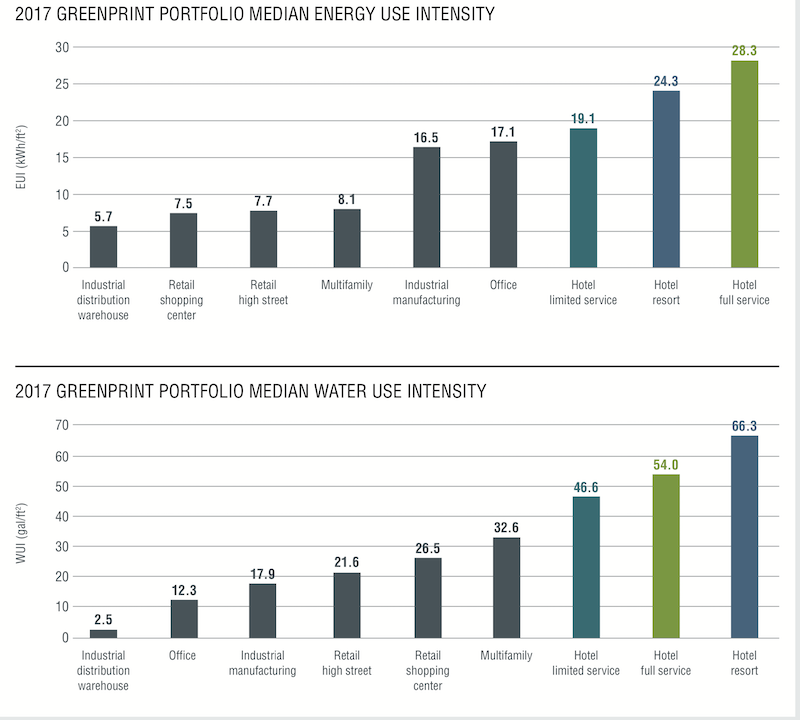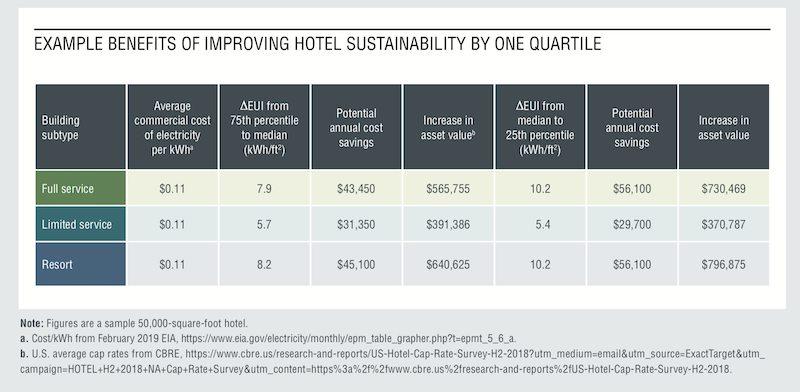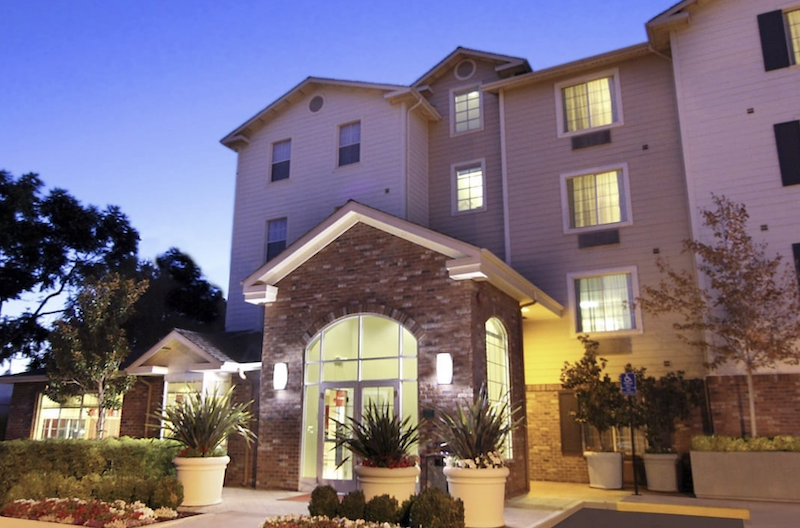A new report about Sustainability in Hotels finds the hospitality industry is still consuming more energy and water than most other commercial and residential sectors. The report, from the Urban Land Institute Greenprint Center for Building Performance, also identifies ways that hotels are becoming more sustainable, and singles out examples of hotels that have taken the necessary steps to reduce their environmental footprint.
The global hotel industry comprises about 184,000 hotels containing almost 17 million rooms, a number that has increased 17.7% from 2008 to 2018.
Of commercial buildings, hotels are among the highest energy and water users per sf (see chart below). The United Nations World Tourism Organization estimates that hotels account for about 1% of global greenhouse gas emissions, a number that is only expected to increase as the industry continues to experience growth and demand. To stay within the 2-degree Celsius threshold for temperature increase agreed upon by the Paris Climate Accord, the hospitality industry would need to reduce emissions 66% by 2030 and 90% by 2050.
The report states that opportunities to improve energy, water, and waste efficiency are widely available for hotels of all types, through operational changes such as utility benchmarking and temperature setpoint adjustments, as well as technical updates like high-efficiency water fixtures or LED lighting installations.
Investments in high-efficiency energy management systems, HVAC retrofits, or on-site renewable energy, require longer project planning and more overall effort. Achieving projects of this magnitude requires collaboration between owners and operators, but can pay long-term dividends for hotels in utility savings and guest comfort.
OPERATING INCOME IS DRIVING SUSTAINABILITY
According to a recent survey of 72,000 Hilton guests, around one third said they prefer hotels with environmental and social programs. Among guests younger than 25, that number jumped to 44%.
Last week, Bee + Hive, a not-for-profit association that unites hotels and partners committed to sustainable tourism, launched a booking platform that will give travelers the ability to plan a vacation based on sustainable experiences.
“Sustainable design is what the market wants,” says W. Edward Walter, ULI’s Global CEO. “Younger and older generations place a high priority on green and sustainable development in how and where they live, work, and play. It’s also what cities need, as they seek to become more resilient, competitive, and livable.”
That being said, the report indicates that the biggest driver of sustainability initiatives in the hotel sector is the potential to improve an asset’s net operating income. “Hotels are a unique asset in that they reap all utility savings from sustainability projects directly to their bottom line, without having to share those savings with tenants.”
In the U.S., hotels in many cities are subject to mandatory utility benchmarking and other building-focused sustainability legislation. New York City’s new building emissions legislation, passed in April 2019, sets carbon dioxide equivalent (CO2e) emissions targets for all building types (for hotels: 9.87 CO2e per sf by 2024 and 5.26 CO2e per sf by 2030).
Many U.S. cities have developed incentives for real estate to “go green” that apply to hotel properties. In Nashville, developments that achieve LEED certification (or another green certification) in the central business district can obtain a density bonus that scales with the stringency of the certification.
Even without sustainability requirements, sustainable features are a strong way to ease community concerns about development, decreasing time spent on approvals and improving project viability. many in the hotel industry have set internal goals for reducing their impact on the environment.

By comparison to other building types, hotels are energy and water hogs, based on the Cornell Hotel Sustainability Benchmarking Index, with which Urban Land Institute has partnered since 2016. Chart: ULI
CASE STUDIES SHOW THE WAY
Hospitality organizations are setting science-based targets for their sustainability goals. In 2019, nine companies, including MGM Resorts International, Hersha Hospitality Trust, and Wyndham Worldwide have committed to setting these targets, and seven—including Hilton, Host Hotels, and Las Vegas Sands—have already had their targets set and approved.
Hilton is committed to cutting emissions 61% by 2030, and Marriott is committed to reduce carbon intensity 30% by 2025.
Hersha, which operates 48 hotels with 7,644 rooms, is cited in the ULI report for its rollout of LED lighting and guest room energy management systems that has saved Hersha’s hotels over $1.5 million annually in utility costs with under 2.5-year payback periods. A more recent rollout of efficiency technology for laundry has reduced Hersha’s water use for laundry by 70-80%. All told, Hersha has reduced its energy use per sf by 15%, its greenhouse gas emissions per sf by 41%, and has diverted 25% of its waste from landfills, saving $11 million since 2010 and creating $65 million additional portfolio value.
Water use in hotels accounts for about 24% of total utility expenses and 15% of total water use in commercial and institutional real estate in the United States. To reduce its intensity, the 23-story 308-room MGM National Harbor Resort & Casino in Maryland, which opened in 2016, installed high-efficiency fixtures that save more than 34 million gallons each year. The hotel’s roof is designed specifically to capture rainwater that is then treated and stored in a 700,000-gallon water cistern. That water is used for irrigation and toilet flushing.
These water efficiency efforts are part of a larger environmentally conscious design strategy at MGM National Harbor, including one of the largest privately operated combined heat and power plants in the Washington, D.C., region.
Sustainability includes environmental stewardship. As part of the high-quality guest experience they want to provide, resorts are protecting their surrounding natural environment and biodiversity. The ULI report points specifically to Terranea Resort, in Rancho Palos Verdes, Calif., which occupies only 25% of its 102-acre site, and conserves 75 acres for natural landscape. Stormwater is channeled through a series of wet ponds and vegetated wetland channels called bioswales for natural irrigation and water treatment, enhancing water quality while serving as a habitat for native avian species.

Savings from sustainable programs can increase the hotel property's value. Chart: ULI
BEST PRACTICES EMPHASIZE DATA SHARING
The ULI report laments, however, that these and other case studies are not more the rule than exceptions to it. It notes that hotels continue to lag in sustainability because owner and operator models create challenges to scale solutions. The lack of data and verification also inhibits future sustainable opportunities. And many hotels still aren’t balancing their sustainability initiatives with their guests’ expectations.
The report offers sustainability best practices for hotels that include:
•Consider sustainability during project design
•Incorporate sustainability into renovations
•Select AEC managers and stakeholders with sustainability expertise
•Collect and analyze energy, water, and waste data to track performance
•Owners and operators should work together to align goals and maintain communication
•Develop the hotel workforce
•Identify partner organizations that can support sustainability programs.
These best practices are likely to be affected, and possibly altered, by trends that are shaping the hospitality sector, such as modular construction, sustainable materials selection, smart-room technology, and a heightened focus on health and wellness.
Related Stories
| Aug 11, 2010
Alabama hospital gets a four-story addition
Birmingham, Ala.-based Hoar Construction has completed the North Tower addition at Thomas Hospital in Fairhope, Ala. The four-story, 123,000-sf addition accommodates an ER on the first floor, 32 private patient rooms and nursing support on the second and third floors, and room for 32 planned patient rooms on the top floor.
| Aug 11, 2010
Florida mixed-use complex includes retail, residential
The $325 million Atlantic Plaza II lifestyle center will be built on 8.5 acres in Delray Beach, Fla. Designed by Vander Ploeg & Associates, Boca Raton, the complex will include six buildings ranging from three to five stories and have 182,000 sf of restaurant and retail space. An additional 106,000 sf of Class A office space and a residential component including 197 apartments, townhouses, ...
| Aug 11, 2010
America's Greenest Hospital
Hospitals are energy gluttons. With 24/7/365 operating schedules and stringent requirements for air quality in ORs and other clinical areas, an acute-care hospital will gobble up about twice the energy per square foot of, say, a commercial office building. It is an achievement worth noting, therefore, when a major hospital achieves LEED Platinum status, especially when that hospital attains 14 ...
| Aug 11, 2010
3 Hospitals, 3 Building Teams, 1 Mission: Optimum Sustainability
It's big news in any city when a new billion-dollar hospital is announced. Imagine what it must be like to have not one, not two, but three such blockbusters in the works, each of them tracking LEED-NC Gold certification from the U.S. Green Building Council. That's the case in San Francisco, where three new billion-dollar-plus healthcare facilities are in various stages of design and constructi...
| Aug 11, 2010
Westin Hotel
Mid-twentieth-century projects are in a state of limbo. In many cities, safeguards against quick demolition don't even cover “new” buildings built after 1939, yet many such buildings may be obsolete by current standards. The Farmers and Mechanics Savings Bank, located in downtown Minneapolis, was one such building, a rare example of architecture from a time when American design was ...
| Aug 11, 2010
Platinum Award: Monumentally Hip Hotel Conversion
At one time the tallest building west of the Mississippi, the Foshay Tower has stood proudly on the Minneapolis skyline since 1929. Built by Wilbur Foshay as a tribute to the Washington Monument, the 30-story obelisk served as an office building—and cultural icon—for more than 70 years before the Ryan Companies and co-developer RWB Holdings partnered with Starwood Hotels & Resor...
| Aug 11, 2010
Hilton President Hotel
Once an elegant and fashionably trendy locale, the Presidential Hotel played host to the 1928 Republican National Convention where Herbert Hoover was nominated for President, and acted as a hot spot for Kansas City Jazz in the '30s and '40s. The hotel was eventually abandoned in 1984, at which point it became a haven for vagabonds and pigeons, collecting animal waste and incurring significant s...
| Aug 11, 2010
CityCenter Takes Experience Design To New Heights
It's early June, in Las Vegas, which means it's very hot, and I am coming to the end of a hardhat tour of the $9.2 billion CityCenter development, a tour that began in the air-conditioned comfort of the project's immense sales center just off the famed Las Vegas Strip and ended on a rooftop overlooking the largest privately funded development in the U.
| Aug 11, 2010
The softer side of Sears
Built in 1928 as a shining Art Deco beacon for the upper Midwest, the Sears building in Minneapolis—with its 16-story central tower, department store, catalog center, and warehouse—served customers throughout the Twin Cities area for more than 65 years. But as nearby neighborhoods deteriorated and the catalog operation was shut down, by 1994 the once-grand structure was reduced to ...
| Aug 11, 2010
Great Solutions: Healthcare
11. Operating Room-Integrated MRI will Help Neurosurgeons Get it Right the First Time A major limitation of traditional brain cancer surgery is the lack of scanning capability in the operating room. Neurosurgeons do their best to visually identify and remove the cancerous tissue, but only an MRI scan will confirm if the operation was a complete success or not.







